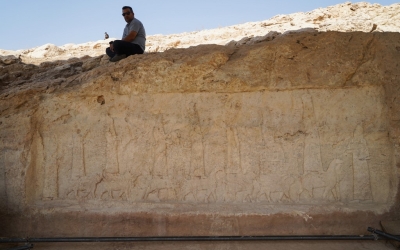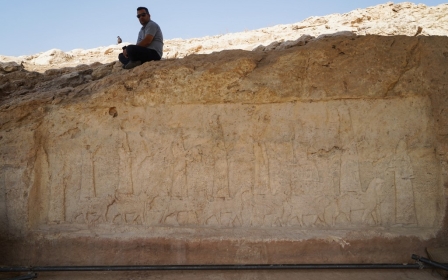New archaeological discoveries in Iraq uncover questions of community ownership

Archaeologists have uncovered previously unseen Assyrian reliefs at a site thought to have been destroyed by the Islamic State group, and with the discovery come questions of protection, preservation and appreciation of local, living communities at the root of these cultural treasures.
Last month, on 11 October, researchers unearthed seven slabs of ancient rock carvings at the Mashki Gate during an ongoing restoration of the site in Mosul, led by a team from the University of Pennsylvania. The university’s Iraq Heritage Stabilization Program collaborates on the project with Iraq’s State Board of Antiquities and Heritage, which manages the country’s heritage sites and museums. Funds for the project come from ALIPH Foundation, Penn Museum and private donations.
"These were completely unknown prior to this," Michael Danti, a University of Pennsylvania archaeologist directing the excavations, told Middle East Eye.
The Islamic State bulldozed a multi-storied 1970s restoration of the Mashki Gate in 2016, leaving little more than a "rubble heap" in their wake, Danti said.
The ancient rock carvings are an estimated 2,700 years old. They were found in what Danti describes as a hallway leading from the main chamber of the gate - impeccably preserved while underground.
New MEE newsletter: Jerusalem Dispatch
Sign up to get the latest insights and analysis on Israel-Palestine, alongside Turkey Unpacked and other MEE newsletters
According to Danti, the reliefs were not originally located at the Mashki Gate but rather decorated the palace of Sennacherib, the neo-Assyrian king who ruled the empire from 705-681 BCE. The team speculates the carvings were either never installed at the palace, or they were, but later moved to Mashki Gate.
"They're really revolutionary in terms of Assyrian sculpture in the way that they portray space," Danti said, noting the detail in the reliefs and their use of a combination of visual art and cuneiform inscriptions to tell stories of Sennacherib's conquests and significant moments from his reign.
Carvings from Sennacherib's palace were destroyed by the Islamic State group, while surviving reliefs were taken to the British Museum, according to Danti. For archaeologists who believed Iraq had seen the last of the remains of Sennacherib's palace, the findings at Mashki Gate were a relief in more ways than one.
"We were not at all expecting them," Danti said. "It's really kind of nice, after what ISIS did."
The site was one of several targets of the Islamic State group's campaign to destroy sites of cultural heritage during its occupation of the region. The group would often share video footage of the destruction. Militants blew up or bulldozed religious and cultural sites across Iraq and Syria while looted artefacts would fund their paramilitary operations.
On Wednesday, Danti's team also discovered a door threshold "with a well-preserved cuneiform inscription" dating back to the rule of the Assyrian king Adad-Nerari III. Danti said a similar threshold was housed in the British Museum.
Modern community
Iraq's Assyrians are a minority in their home region. An estimated 150,000 remain in the country today, compared with 1.5 million before the US invasion. Along with Yazidis and other native minorities and ethnoreligious groups, Assyrians were victims of targeted persecution by IS between 2014 and 2017.
Members of the Assyrian community in the diaspora and at home trace their ancestry to the ancient empire, and they celebrated the discovery of the fully preserved artefacts, which many consider a fundamental part of their heritage.
Despite what seems an obvious connection, when it comes to archaeological projects in the region, authorities tend to leave the modern Assyrian community behind, say locals.
Helen Malko, an archaeologist based in Amman, told Middle East Eye that engagement of local communities is crucial to equitable processes.
"If you say this heritage is important for the Iraqi people, then it's important for Assyrians," Malko said.
This month, authorities in Iraq's Kurdistan region unveiled an "archaeological park" in partnership with Italy’s University of Udine. Known as the Faida Archaeological Project, it features 13 slabs of carved Assyrian reliefs along a 1.5km stretch of a 10km canal, dating back to the rule of Sargon II and his son, Sennacherib. It’s part of a five-site archaeological park still in progress.
Attendees at the October 16 unveiling ceremony included Italian and Kurdish representation. According to Daniele Morandi, a University of Udine archaeologist co-directing the project at Faida, Assyrian representatives were also present.
Those representatives included Chaldean church officials Thabet Habib Youssif al-Mekko, bishop of al-Qosh; Azad Sabri Shaba, bishop of Duhok; Ghazwan Youssif Baho, parish priest of Sheikhan, and Lara Yousif Zara, the Alqosh mayor whom advocacy groups and many local Assyrians say was installed by the dominant Kurdistan Democratic Party.
"A religious figure doesn't represent the community, necessarily," Malko said. "He represents his church."
She said inadequate representation could leave communities feeling "excluded and pushed aside as a minority group".
"They feel it doesn't matter what the outsiders think about the connection the Assyrian community feels to this heritage," she said. "Outsiders can say anything they want, but for them, for the community, this heritage means a very specific thing."
Morandi says community engagement will remain a priority.
'[Assyrians] are alienated by those who are doing the work'
- Helen Malko, archaeologist
Efforts to put that insight into practice include inviting local schools and children to visit projects, he said.
"It's a very critical part of our job," Morandi said. "I'm not talking only about the Assyrian community… [If] the Yazidi community, the Kurdish community, the Arab community don't know this cultural heritage, the task of protecting and enhancing this cultural heritage becomes harder."
But such practices need to be adopted by foreign and local researchers in the broader field of archaeology for them to yield results, according to Malko.
"This keeps happening in Iraq, unfortunately, even though we witnessed the destruction of this heritage and the people at the same time," Malko said. "[Assyrians] are alienated by those who are doing the work."
Extra protection and tourist attractions
Archaeological sites are "endangered by urban growth, by the expansion of productive activities, by neglect and by vandalism", Morandi said.
At the Mashki Gate, workers are in the process of protecting and clearing the site, according to Danti, who says the work requires extra care. The recently discovered reliefs, made of a material commonly referred to as "Mosul marble" - which is not marble at all, but a form of gypsum - makes them particularly vulnerable to wear by the elements.
"Even a little bit of rain or snow on it can do significant damage," Danti said.
Meanwhile, vandalism and looting have plagued cultural heritage sites in Iraq for decades, particularly since the US-led invasion in 2003.
'The period of colonial appropriation of cultural heritage, fortunately, has come to an end'
- Daniele Morandi, archaeologist
"Mosul is a really booming city again," Danti said, "and Nineveh itself [is] sort of right in the middle of it all."
Once the site is secured by temporary roofing and other such protective measures, workers will "manufacture Assyrian-size bricks" and rebuild the structure, Danti said, which will eventually function as a visitors' centre for tourists.
"I think it'd be a fairly major cultural asset for SBAH and for local tour guides," Danti said.
Meanwhile at Faida, more than 1,000 visitors have been to the site within just 10 days of its opening, according to Morandi, who said many were Assyrians "flocking from the surrounding villages, particularly from the area of Alqosh".
At both sites, archaeologists promise artefacts will remain in place.
"The period of colonial appropriation of cultural heritage, fortunately, has come to an end," Morandi said. "The rock reliefs will stay in Iraq."
Middle East Eye delivers independent and unrivalled coverage and analysis of the Middle East, North Africa and beyond. To learn more about republishing this content and the associated fees, please fill out this form. More about MEE can be found here.





